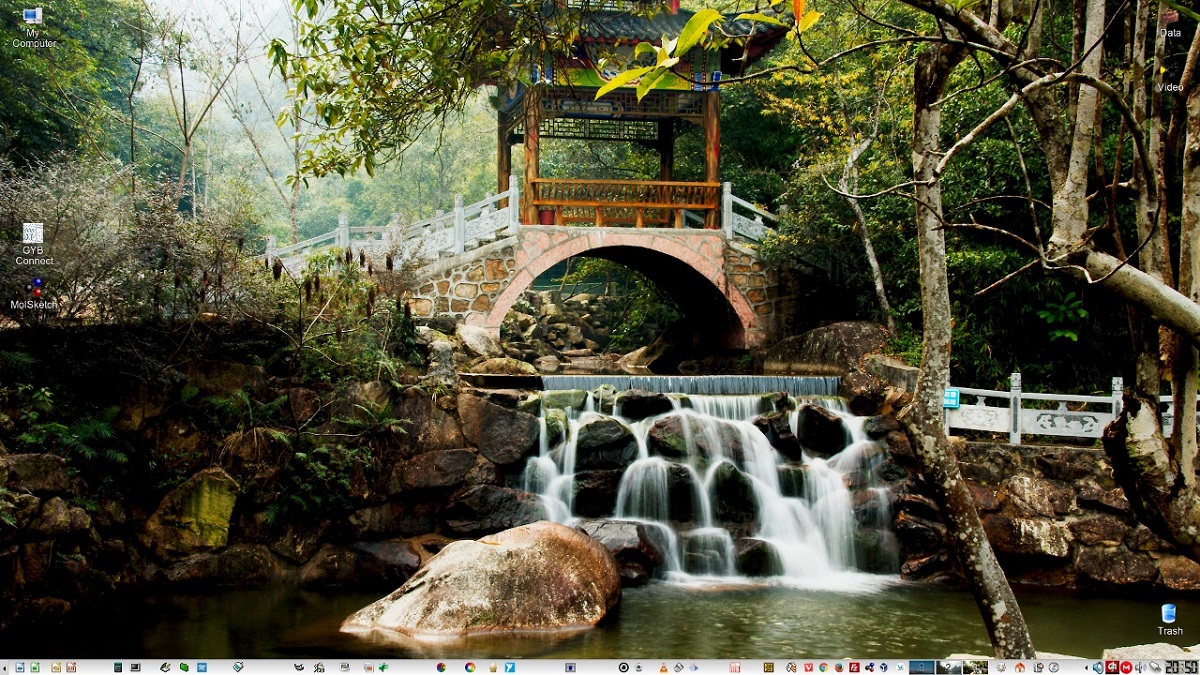
The developers of the “Trinity” desktop environment They are partying and it is that not only are pleased to announce their XNUMXth anniversary of the project but have also announced the release of the new version of the Trinity R14.0.8 desktop environment.
For those who are unfamiliar with this desktop environment, they should know that this builds on continued development of the KDE 3.5.x and Qt 3 code base. Trinity's features include proprietary tools to control screen parameters, a udev-based layer for working with teams, a new interface for configuring teams, switching to Compton-TDE composite manager (Compton fork with TDE extensions ), an improved network configurator and user authentication mechanisms.
The Trinity environment can be installed and used simultaneously with the latest versions of KDE, including the ability to use Kinity apps already installed on the system in Trinity. There are also tools to correctly display the interface of GTK programs without violating a single design style.
What's new in Trinity R14.0.8?
In the new version a number of changes were introduced related to debugging and work to improve the stability of the code base. Such is the case of continuing with the transfer of packages to the Cmake build system, since for some packages, support for compiling with automake is completely discontinued.
Also the work carried out to improve the compatibility of the environment is highlighted on the Pinebook Pro device, improved support for LibreSSL and musl libc and also improved support for XDG directories.
We can also find in the new version a new configuration what was added to disable tdekbdledsync and another that was added to choose the default file manager.
Issues resolved when determining cover closure, battery charge, and CPU number for some systems, as well as correcting problems related to vulnerability CVE-2019-14744 (Execution of arbitrary commands when viewing a directory containing specially crafted ".desktop" files).
Of the other changes presented in this new version:
- Initial support was provided for repeat builds.
Added the ability to translate desktop files using the Weblate service. - The compilation process for FreeBSD based on Cmake has been changed to use the Ninja utility.
- Discontinued support for Kerry and code associated with the Beagle search engine
- Avahi is compatible time.
- Improved support for the DilOS distribution (a distribution based on the Illumos kernel, which uses dpkg and apt to manage packages).
- A call to the selected terminal emulator is provided through the "Open Terminal" menu.
How to install Trinity desktop R14.0.8?
For those interested in being able to install this desktop environment on their systems, You can follow the instructions we share below.
For those who are users of Ubuntu, Linux Mint or any derivative of these, the first thing we are going to do is add the environment repository to our system, so for this we are going to open a terminal in the system and we are going to type the following:
echo "deb http://mirror.ppa.trinitydesktop.org/trinity/deb/trinity-r14.0.x $(lsb_release -sc) main" | sudo tee /etc/apt/sources.list.d/trinity.list
echo "deb http://mirror.ppa.trinitydesktop.org/trinity/deb/trinity-builddeps-r14.0.x $(lsb_release -sc) main" | sudo tee /etc/apt/sources.list.d/trinity-builddeps.list
Already added the repository to the system, immediately afterwards we are going to download and import the public key into the system with the following command:
wget http://mirror.ppa.trinitydesktop.org/trinity/deb/trinity-keyring.deb sudo dpkg -i trinity-keyring.deb
After that we will proceed to update our list of packages and repositories with:
sudo apt-get update
Finally we are going to install the environment in our system with:
sudo apt-get install kubuntu-default-settings-trinity kubuntu-desktop-trinity
Now for those who are openSUSE leap 15.1 users, they can install the environment by running the following commands:
rpm --import http://mirror.ppa.trinitydesktop.org/trinity/trinity/rpm/opensuse15.1/RPM-GPG-KEY-trinity zypper ar http://mirror.ppa.trinitydesktop.org/trinity/trinity/rpm/opensuse15.1/trinity-r14/RPMS/x86_64 trinity zypper ar http://mirror.ppa.trinitydesktop.org/trinity/trinity/rpm/opensuse15.1/trinity-r14/RPMS/noarch trinity-noarch zypper refresh zypper install trinity-desktop
While for those who are Arch Linux users or some derivative, you can compile the environment by following the instructions in this link or add the following repository to your pacman.conf file
[trinity] Server = https://repo.nasutek.com/arch/contrib/trinity/x86_64
They update and install with:
sudo pacman -Syu sudo pacman -S trinity-desktop
For all other Linux distributions, They can follow the instructions that are shared on the official website of the environment.
Good news, I use Trinity in Debian and I am very satisfied, on old computers it works very well, I think it is better than LXQT, TDE has more applications, it is more versatile and faster.
It is a very good environment, I use it on a Raspberry with Q4OS and from my point of view it shows good performance.
Why use kubuntu-defaults? What does kubuntu have to do with TDE? Excuse me but I don't understand that part. I have installed TDE following instructions from the official Debian website https://wiki.trinitydesktop.org/Debian_Trinity_Repository_Installation_Instructions and nowhere does he mention kubuntu. For the rest very good article. Thanks for sharing.
The packages you mention refer to the installation of desktop environment settings and illustrations for Ubuntu (the same applies for derivatives). In the case of Debian the packages differ, that's why you don't see the same packages (although in theory they should be the same, but I honestly don't know how they differ from each other).
Regards!